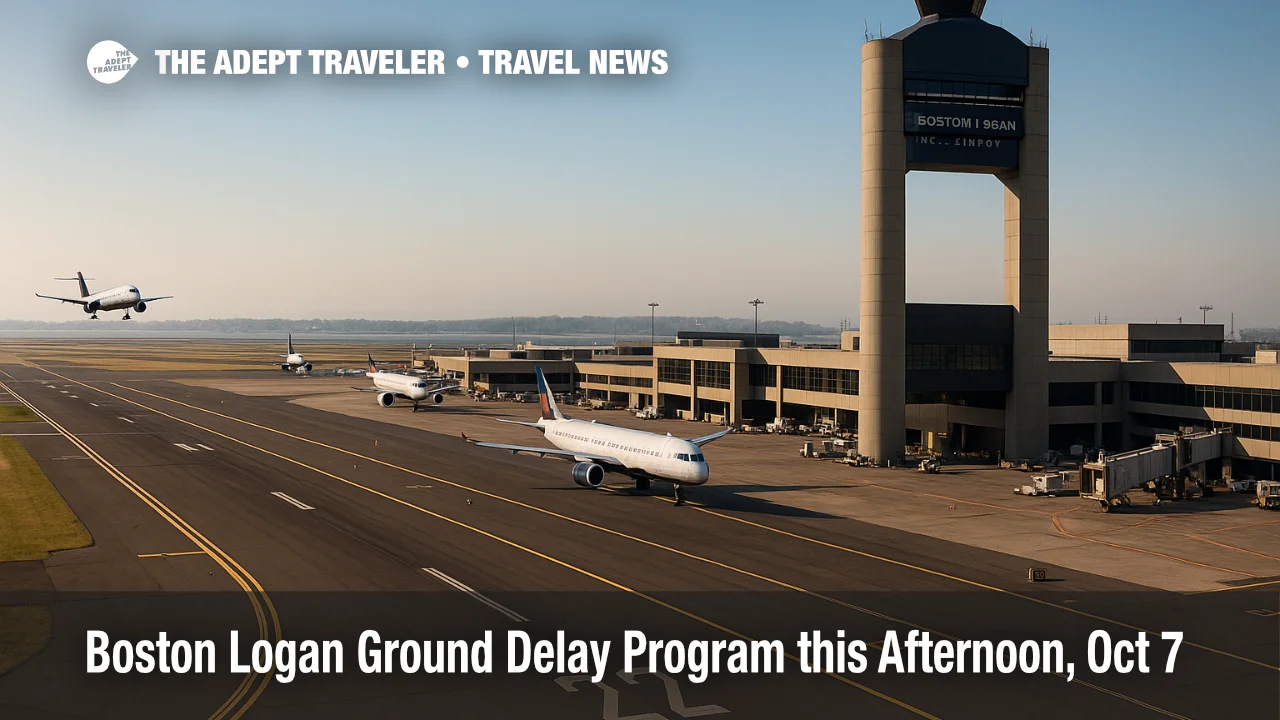Boston Logan GDP this afternoon as runway work compresses arrivals

A Ground Delay Program is in effect at Boston Logan International Airport (BOS) this afternoon and evening as runway and taxiway construction reduces the airport's arrival capacity. The FAA set the program window from 100 p.m. to 1059 p.m. ET, with an average delay of about 55 minutes and a maximum near 220 minutes. Scope covers most U.S. departure centers and key Canadian origins, and today's rate plan meters BOS arrivals through the evening push. Travelers with tight connections into or out of Boston should expect knock-on schedule changes and gate holds.
Key points
- Why it matters: Runway work limits arrivals, pushing rolling delays into the evening bank.
- Travel impact: Average 55-minute waits; some flights face delays approaching 3 hours.
- What's next: Rates step up late evening as demand tapers, but program runs to 10:59 p.m. ET.
- EDCTs govern push times for most U.S. and select Canadian departures bound for BOS.
- Using airline reflow tools and EDCT checks can preserve connections and seats.
Snapshot
FAA's Command Center issued a Collaborative Decision Making Ground Delay Program for BOS due to "RWY-TAXI / CONSTRUCTION." The cumulative period is 100 p.m. to 1059 p.m. ET, with a uniform arrival rate plan during the peak hours and a higher rate late night as demand falls. The program applies to all contiguous U.S. departures within listed ARTCCs, plus select Canadian airports, which means most BOS-bound travelers will receive an EDCT controlling pushback. Massport's concurrent closure of Runway 9/27 through mid-November is the root capacity constraint, so afternoon and evening programs may recur during bank periods while work continues.
Background
Massport is conducting FAA-required runway safety work that closes Runway 9/27 through mid-November, tightening BOS arrival acceptance rates during peak hours. When demand exceeds that reduced rate for a sustained period, the FAA uses GDPs to meter arrivals and minimize airborne holding by assigning each BOS-bound flight an EDCT. Under CDM, airlines can make substitutions and reflow their schedules to better match the program, but passengers will feel the impact as gate holds, departure resequencing, missed connections, and rolling arrival delays. Similar BOS GDPs have appeared throughout September and into October as the construction phase overlaps afternoon demand peaks.
Latest developments
FAA sets BOS GDP 100 p.m.-1059 p.m. ET with wide scope and construction as the trigger
FAA's "Most Recent ATCSCC Advisory" lists a BOS/ZBW CDM Ground Delay Program with arrivals estimated 1700Z-0259Z, matching 100 p.m.-1059 p.m. ET. Today's plan uses UDP assignment with rates holding near 38 arrivals per hour through the core period, stepping up later as demand eases. Average delay sits near 55 minutes, with a published maximum of 220 minutes. Scope includes all contiguous U.S. departures across major ARTCCs and Canadian departures from Toronto, Montréal, Ottawa, Québec City, Halifax, and Toronto City. The impacting condition is runway and taxiway construction, with BOS on a 22L arrival and 22R departure configuration.
Analysis
Operationally, this is a textbook construction-driven GDP. Closing Runway 9/27 forces BOS to work a single primary arrival runway and one departure runway, trimming the arrival acceptance rate enough that the afternoon push cannot fit without metering. The FAA's rate string near 38 arr/hr aligns with historical BOS GDPs during constrained configs; it smooths the demand hump and limits airborne holding but pushes delays to origin gates. Because scope spans nearly all U.S. centers plus selected Canadian airports, expect EDCTs even from medium-distance outstations. Airlines will use reflow tactics, swapping flights and seats within fleets to protect hub-connectivity and last banks. That reflow can save misconnects for some, but it also means equipment swaps and rolling boarding-time changes are likely through the evening.
What this means for you: If you are connecting in Boston this afternoon or evening, build a minimum two-hour buffer where possible. Monitor your EDCT in the airline app and at the gate; crews cannot depart early under a GDP. If your connection drops below 45 minutes, ask the airline for rebooking options before you depart, which is easier than reticketing after you misconnect. For BOS-origin travelers, consider moving to a later flight that departs after the GDP rate step-up or rebooking to a nonstop to avoid missed connections downline.
How to use EDCTs and reflow tools to minimize missed connections: Check your flight's EDCT within 45 minutes of scheduled departure using the FAA's lookup tool, then compare it to the airline's posted boarding and push times. If your EDCT slides past your downline connection's departure, call or chat with the airline to request a voluntary reflow: seats on a later BOS-bound flight with an earlier EDCT, a connection-saving routing, or a protected overnight with meal and hotel where policies allow. Elite lines and corporate booking tools can sometimes see swap inventory faster during active CDM.
Final thoughts
Construction will keep BOS capacity tight through mid-November, so afternoon GDPs could remain common on busy days. Travelers who treat EDCTs as the controlling time and who proactively reflow with their airline have the best shot at keeping trips intact. Keep an eye on the advisory page and your airline app, and plan conservatively for late-day arrivals. Until the runway work wraps, a Boston Logan ground delay program is a fact of life.
Sources
- ATCSCC Advisory: BOS/ZBW CDM Ground Delay Program, effective 1700Z-0259Z, average 55 minutes, max 220, construction trigger, FAA
- BOS airport status page: GDP due to runway-taxiway construction, average delays about 55 minutes, FAA
- Current Operations Plan: BOS GDP probable; BOS Runway 09/27 closure listed through November 15, FAA
- Runway 9/27 construction through mid-November, Massport
- EDCT lookup guidance, FAA
- Ground Delay Program policy and procedures, FAA
